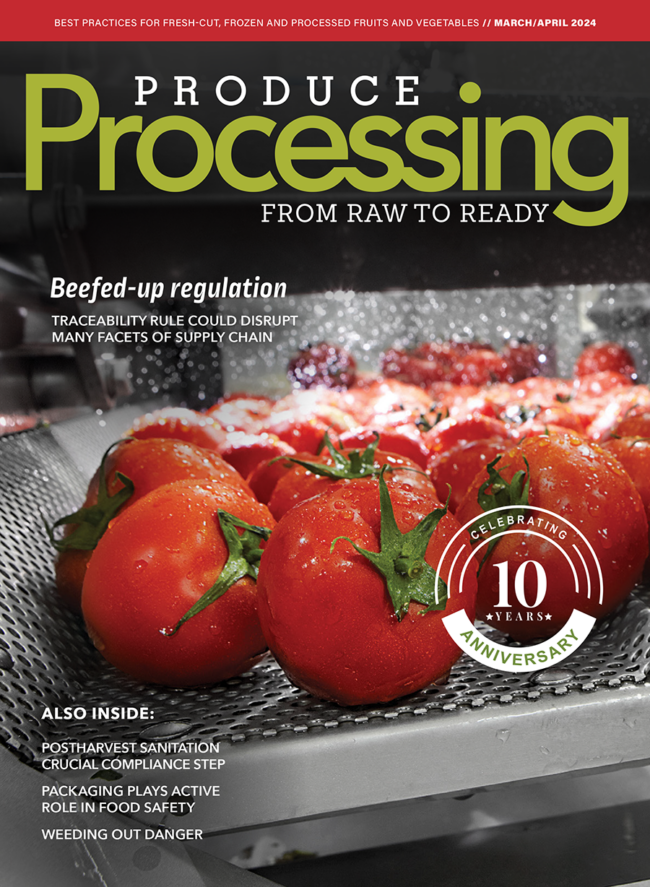Up-and-down shipping industry can have big effect on produce transit
Shipping is an essential part of the food supply chain and a significant factor in everyone’s bottom line along the way.
Transit costs can be volatile; they hinge on any number of factors beyond food producers’ control, such as oil prices, availability of truck drivers and weather.
Idaho not only produces more potatoes — one of the most consumed and versatile vegetables in the world — than any other U.S. state, it also produces more spuds than any other region in the Western Hemisphere. Idaho’s distance from large North American population bases and seaports has always made shipping a challenge.

“Approximately 60% to 70% are moved by truck, with the other 30% to 40% moved by rail,” said Shawn Boyle, president of the Idaho Grower Shippers Association (IGSA). “If you would have asked me those numbers 15 to 20 years ago, they would have been about reversed.”
The trucking industry has been unstable in recent years. In December 2017, required compliance of the Federal Motor Carrier Safety Administration’s (FMCSA) Electronic Logging Device rule for tracking drivers’ hours of service went into effect. For months, it caused delays and backlogs in product movement while the industry adapted.
Driver shortage?
The struggle to get goods moved in a timely manner in 2018 wasn’t lost on end consumers. The Washington Post ran a series of articles that documented a shortage of drivers to move freight, quoting industry estimates of some 63,000 unfilled driver positions.
Eric Arling, director of operations of Integrity Express Logistics, which is based in Cincinnati, said the market for talented drivers can be very competitive. The situation in 2018 was an unusual one, however, as it was the result of numerous factors coming together, including a strong economy, major storms and the aforementioned ELD compliance situation.

“From a capacity standpoint, we’ve done very well, especially in 2018. That was a unique year with the compression of the market,” said Arling, whose company is involved in moving produce, among other products. “You had the backlog from two different hurricanes, you’ve got ELDs and you throw tax cuts in there as well.”
Capacity shortages, as in 2018, result in a correction on the part of carriers through increased wages and incentives to lure new drivers. Data reported by FreightWaves, which monitors the freight industry, in early September showed that 26,500 drivers had been added to the for-hire trucking workforce during the previous 10 months.
FreightWaves CEO Craig Fuller, in a Sept. 2 editorial, cautioned of overcorrection, however. He warned not only of lower standards for new drivers as being dangerous, but also of any reduction in the amount of freight, which can happen as a result of an economic shift, leading to carriers going bankrupt.
Transit Topics, another freight-focused publication, recently reported that more trucking firms shut down the first six months of 2019 than did during all of 2018.
Improving efficiency
Moving a perishable product comes with an additional set of challenges, which are only intensifying with increasing food safety regulations and public demand for transparency. Fortunately, technological advancements continue to evolve.
Climate-controlled shipping containers are not new, but automated temperature monitoring and transit alerts have helped everyone — from the packing shed to the retailer — be more efficient.
“I think the biggest thing that’s probably unique to perishables is the TempTale technology and getting live alerts on the road,” Arling said. “We’re able to set the device to, if (the climate) gets out of range, to correct mid-transit.
“Then, there is freight visibility. Yes, it’s nice to have the temperature monitor on there, but it’s nice to have visibility on if that person is making proper miles. If they’re getting behind, it gives you an opportunity to contact your end shipper and let them know what’s going on.”
Zack Pace is a national account manager at Integrity Express Logistics. Pace, who primarily ships bulk potatoes, said constant communication between shippers, drivers and receivers is paramount.
“That’s the No. 1 way that I service my customers is making sure the shipper knows exactly when the trucks are going to be there,” Pace said. “If they are going to be spread out, they can utilize their manpower in other ways and keep them working. … We don’t want to be late and waste their employees’ time.”
It’s the responsibility of shippers and receivers to do the same, said Boyle, who added in previous years situations were not uncommon where a driver could be an hour late in arriving to pick up a load and then stand around for three hours while the warehouse crew finished up another job.
“One of my goals is to help our shippers be preferred shippers,” Boyle said. “If it’s a nice facility, they treat the drivers well and load them quickly, then (the drivers are) going to want to go there.
“Ultimately, we’re going to get better rates.”
Arling said a location’s reputation does spread within the trucking industry.
“Some of the larger carriers and brokers are beginning to rate shippers for their in-and-out times,” Arling said. “We have customers all the time where you’ll find a truck and tell them where (the warehouse is) and they’ll say, ‘Thanks, but no thanks; last time I was there I got hung up all day.’”
ELD agriculture exemption
To help reduce the likelihood of perishable products going to waste, the FMCSA allows drivers moving agricultural commodities to turn off ELD devices when they are within 150 air miles of their destination.
Boyle feels the agriculture exemption is widely underused and could be a major asset to the industry. Arling and Pace said the reason the exemption isn’t used more often is because it’s vaguely defined, opening it to inconsistent enforcement from state to state.
“It’s fairly gray. They have attempted to clarify it, but I don’t know that anybody feels terribly confident that they can implement the proper usage if they’re unfamiliar with it,” Arling said. “We’re going to generally stay away and let (drivers) follow state and federal laws as they understand them. We don’t want to get people into a situation where a state trooper might have a different interpretation of that law and then you have a mess on your hands.”
The IGSA went an extra step by working with the governor’s office and Idaho State Police to create an official letter that details how the state would enforce the rule.
“We give this letter to drivers in case they are pulled over and there is any question,” Boyle said.
Arling and Pace said such additional clarification would be helpful in other states and regions.
“If you’re particularly active in a certain region, certainly familiarize yourself with the folks who will be on the enforcement side,” Arling said.
Rail
While the current truck-rail rate of shipping for IGSA members is in the 60-40 or 70-30 range, Boyle said an ideal ratio would be closer to 50-50, given Idaho’s isolated locality.
Current IGSA efforts include having a rail-center facility built in eastern Idaho. Part of the reasoning is to reduce the distances drivers have to travel.
“I’ve focused on a lot on rail as a possible solution. We’re working with a business out of Salt Lake (City) to build an intermodal facility in Pocatello,” he said. “We’ll have trucks transporting it to that location — so they’re making short runs — and then rail heading east or to the west coast to be exported by ship.”
Boyle feels that while additional rail shipping would be a positive development, but in many cases trucks will always be the preferred option.
“You can put so much more product in a rail car, but a lot of times people just don’t want that much product at one time,” he said.
— By Zeke Jennings, managing editor
RELATED: Produce organizations seek ELD exemption modifications







